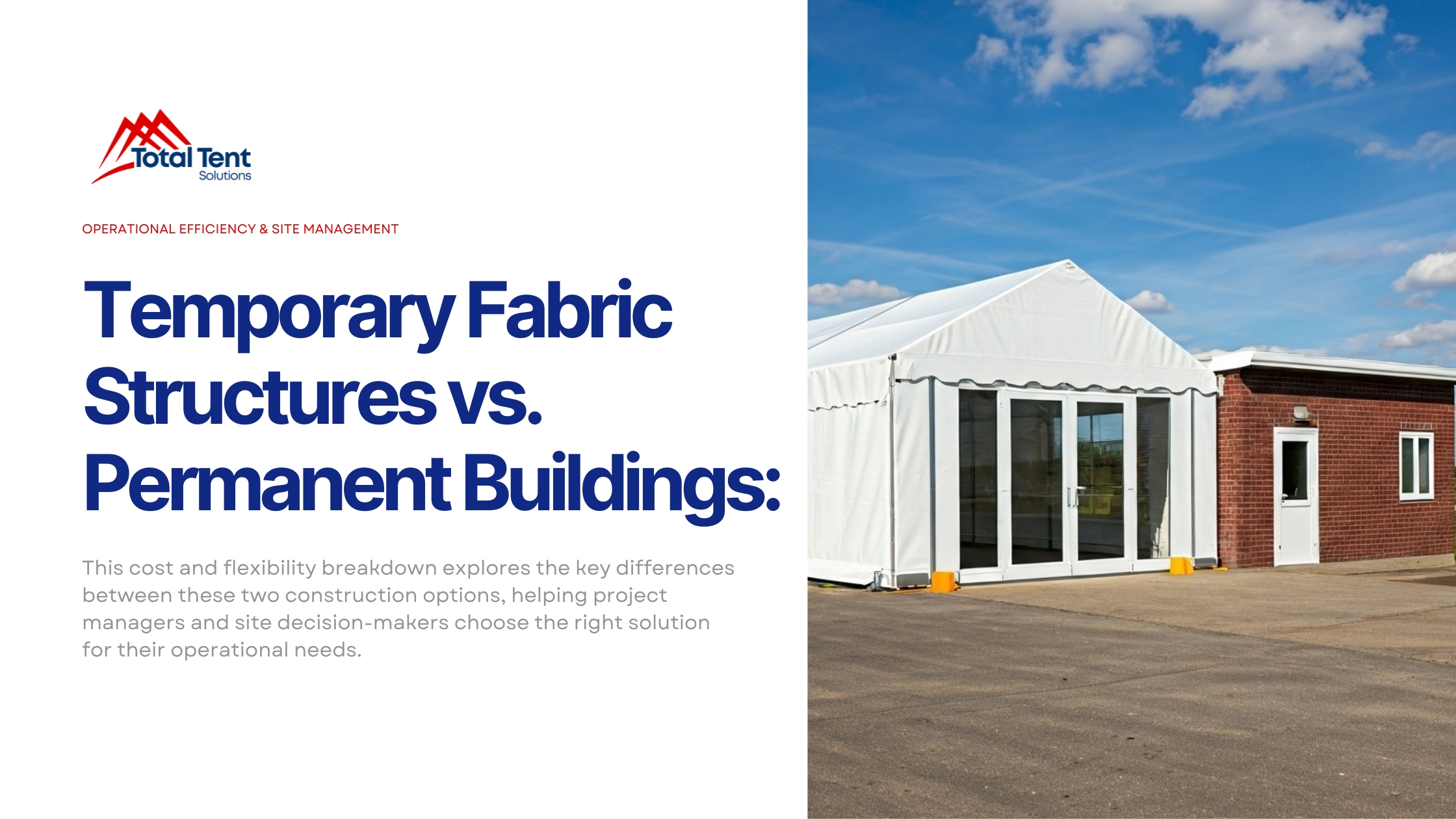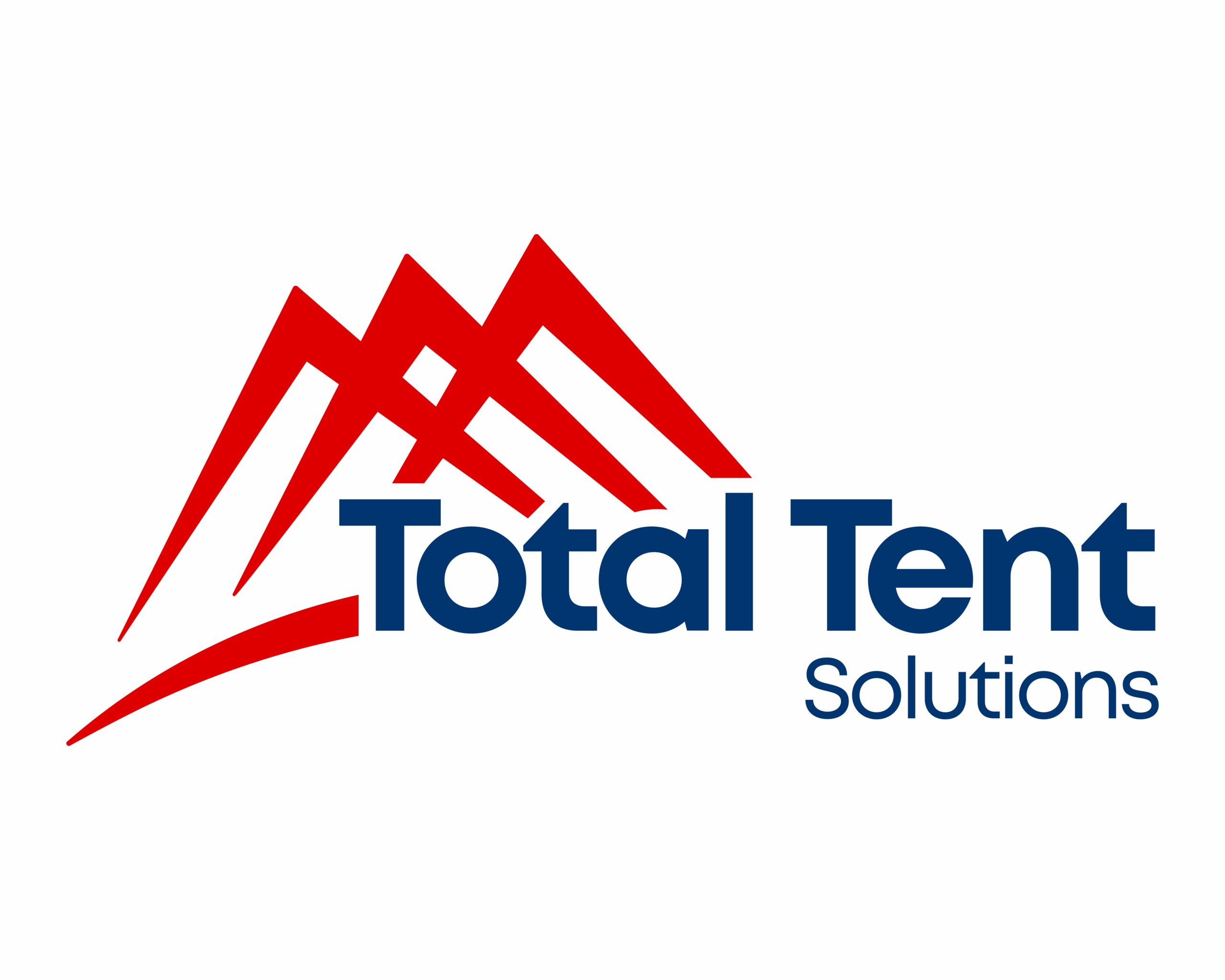
When it comes to creating new operational space, businesses face a critical decision: go with a traditional permanent building or opt for a temporary fabric structure. On the surface, it might seem like a straightforward choice, but once you dig into the cost implications, timeline requirements, and long-term flexibility, it becomes clear that the decision has serious consequences for your budget and operations. In this article, we’ll break down the real differences between the two, so you can make a smart, strategic decision that fits your needs today and tomorrow.
Why the Comparison Matters
Choosing between a permanent structure and a temporary one isn’t just about construction preferences. It’s a strategic decision that affects your financial planning, speed to market, and adaptability. In fast-moving industries like construction, oil and gas, logistics, and emergency response, agility often trumps tradition. That’s why it’s essential to understand what you’re really getting into with each option, not just in terms of materials, but in terms of the bigger picture: how the structure will serve you over time.
A Quick Snapshot of the Two Options
Temporary fabric structures are lightweight, modular buildings made from a rigid frame (typically aluminum or steel) and a high-tension fabric cover. They’re designed to be installed quickly and offer flexibility in both design and deployment. Permanent buildings, by contrast, are constructed from concrete, steel, brick, or wood. They require full-site preparation and are built to last for decades. Each has its place, but the best choice depends on your specific situation.
Understanding Temporary Fabric Structures
What Are Temporary Fabric Structures?
A temporary fabric structure is a modular, engineered building that combines a steel or aluminum frame with a high-strength fabric membrane. These structures are designed for rapid installation and can be used for weeks, months, or even years depending on the application. Despite the word “temporary,” these buildings can offer impressive durability and weather resistance, especially when professionally engineered and installed. They’re often used when speed, cost, and flexibility are more important than long-term permanence.
Common Uses in Industrial and Commercial Sectors
Fabric structures have found a solid place in many commercial and industrial applications. They’re not just a fallback option, they’re often the preferred solution due to how adaptable they are. In industries like oil and gas, construction, and emergency response, time is money, and temporary structures help teams move fast while staying protected.
Oil and Gas
In oil and gas operations, time-sensitive projects like turnarounds, shutdowns, or maintenance windows require infrastructure that can be quickly deployed. Fabric structures serve as mobile command centers, equipment storage, and crew shelters that can be installed on-site with minimal preparation.
Construction and Turnarounds
On large construction sites, temporary structures provide sheltered areas for staging, warehousing, break or lunch space, and on-site offices. Their modularity allows them to expand or relocate as project needs evolve. And because they can be set up so quickly, they won’t delay progress when site conditions change.
Emergency and Disaster Relief
When natural disasters strike, there’s no time to wait on permits or months of construction. Fabric structures provide emergency shelter, medical stations, and supply depots. Their rapid deployment saves lives and restores order faster than any traditional building ever could.
What Are Permanent Buildings?
Defining Permanent Structures
Permanent buildings are what most people picture when they think of traditional construction: brick, concrete, steel, or wood-framed facilities with insulation, plumbing, and built-in HVAC systems. These buildings are designed for long-term or permanent use and are often customized for specific functions. They also tend to be more aesthetically refined and regulated by strict building codes. They’re ideal when permanence, appearance, and resale value are key considerations.
Common Applications and Industries
Permanent buildings are widely used across industries that require long-term operational stability. Whether it’s a warehouse, a factory, or a corporate headquarters, these buildings provide the infrastructure needed for ongoing operations.
Warehousing and Logistics
Warehouses that store large inventories or serve as distribution hubs often favor permanent buildings because of their structural longevity and integrated features like loading docks and automation systems.
Manufacturing Plants
Manufacturing requires a stable, controlled environment with heavy power infrastructure and long-term investments in equipment. Permanent buildings offer the kind of foundation and customization that these facilities demand.
Retail and Office Spaces
When customer impression or professional image matters, permanent buildings shine. They offer modern amenities, curb appeal, and long-term comfort for employees and clients alike.
Cost Comparison
Initial Investment
Temporary fabric structures typically cost a fraction of what a permanent building does, often between 20% and 40% of the cost per square foot. That’s a huge difference, especially for projects working on tight budgets. Permanent buildings involve a lot more in upfront costs: design, permitting, foundation work, materials, and labor.
Construction Timeline and Labor Costs
One of the biggest cost savers with fabric structures is speed. These buildings can be assembled in a matter of days or weeks depending on size. Permanent buildings, on the other hand, often take several months or even over a year to complete. That added timeline translates into higher labor costs and longer delays before the space becomes usable.
Maintenance and Operating Expenses
Fabric structures are easier to maintain over time. Their materials resist mold, rust, and pests, and because they don’t have complex HVAC or plumbing systems built in, there’s less that can break. Permanent buildings can require ongoing upkeep for roofing, plumbing, and systems that drive up costs over the life of the structure.
Tax Implications and Depreciation
Permanent buildings are capital assets that depreciate over many years. Temporary structures may qualify as equipment or temporary installations, which often allows for faster write-offs and different tax treatment. This could be a win for your accountant and your cash flow.
Financing Options and Capital Allocation
Many companies choose to lease or rent temporary structures, which keeps capital free for other priorities. Permanent buildings often require financing or cash reserves, tying up resources that could be used elsewhere.
Flexibility and Adaptability
Site Requirements and Customization
Fabric structures can be installed on a wide range of surfaces, gravel, asphalt, compacted soil, or concrete. You don’t need extensive site preparation. Permanent buildings almost always require leveling, grading, and poured foundations, which add time and cost.
Scalability for Growth
Temporary structures can be expanded or reconfigured as your needs change. Need another 20 feet of storage or an extra bay for equipment? Add it on without tearing down the existing structure. With permanent buildings, scaling up often means major renovations or building from scratch.
Mobility and Relocation
Try moving a concrete warehouse across town. Not gonna happen. But a temporary structure? It can be disassembled, moved, and rebuilt at a new site. That’s a level of mobility that permanent construction just can’t match.
Adjusting to Changing Regulations or Conditions
If new zoning laws or site requirements pop up, temporary structures give you more wiggle room. They’re easier to modify or move, while permanent buildings might be stuck dealing with expensive upgrades or forced relocations.
Time to Deployment
How Long Does It Take to Get Up and Running?
A temporary fabric structure can be installed and operational in as little as a few days. That’s a massive advantage for companies racing against project deadlines. Permanent buildings, on the other hand, require extensive design, permitting, and construction phases. It could be months before the space is usable.
Impact of Delays and Downtime on Business
Delays cost money, lost productivity, missed deadlines, and stalled operations. With a faster deployment timeline, fabric structures help companies avoid those costly delays and stay on schedule, even when circumstances shift.
Environmental and Sustainability Considerations
Material Impact
Fabric structures use fewer raw materials and generate less construction waste. That makes them a better option for organizations trying to reduce their environmental footprint. Permanent buildings are resource-heavy and create more long-term waste when demolished.
Energy Efficiency
Modern fabric membranes can be designed to reflect sunlight and reduce interior temperatures, cutting down on cooling costs. They also often incorporate natural light, which reduces the need for artificial lighting. Permanent buildings can be efficient, but retrofitting them for energy performance can be expensive.
Reusability and End-of-Life Options
At the end of their service, temporary fabric structures can be relocated, resold, or recycled. Permanent buildings don’t have that kind of flexibility. Once their time is up, they’re torn down, leaving behind waste and demolition costs.
Safety, Durability, and Compliance
Structural Integrity Over Time
Don’t let the word “fabric” fool you. High-quality temporary structures are engineered to handle wind, snow, and seismic activity. While they may not last as long as brick and mortar, they’re built to perform reliably throughout their intended use.
Meeting Industry Standards
Professional-grade fabric structures are manufactured to meet building codes and safety standards including IBC, ASCE, and NFPA requirements. You can trust them to provide safe shelter for people and equipment alike.
Resistance to Weather and Environmental Hazards
These structures are surprisingly tough. Fabric membranes can be UV-treated and weatherproofed, while the frames are designed to withstand challenging environments. Whether it’s heat, cold, or coastal wind, engineered structures hold their ground.
Use Case Scenarios: Real-World Applications
When Temporary Makes the Most Sense
Short-term projects, seasonal needs, or rapid-response deployments are tailor-made for temporary structures. If you need to set up fast, adapt to changing conditions, or operate on a limited budget, fabric structures are the clear winner.
When a Permanent Building is the Right Fit
Long-term operations, branding-sensitive environments, and facilities with complex infrastructure requirements are better suited for permanent buildings. They offer longevity, aesthetics, and higher resale value when properly maintained.
Long-Term Value Assessment
ROI and Payback Period
Because of their lower upfront costs and shorter timelines, temporary structures often deliver ROI much faster. Permanent buildings take longer to pay off, but may deliver higher returns over the long haul if maintained well and used continuously.
Hidden Costs Over Time
Permitting delays, unexpected repairs, insurance, and taxes can add up quickly for permanent buildings. Fabric structures come with fewer surprises and more predictable cost profiles.
Future-Proofing Your Space
Adapting to Market Trends
Business needs change quickly. Fabric structures let you pivot without tearing down walls. Need to downsize? Relocate? Add space? You can.
Planning for Uncertainty
Not sure where you’ll be in five years? A temporary structure gives you the flexibility to stay nimble and avoid locking into expensive commitments.
Decision-Making Checklist
Questions to Ask Before Choosing
What’s the expected lifespan of your project? Do you need the ability to relocate? How important is speed? What’s your total budget, upfront and ongoing? Your answers will point you in the right direction.
Common Mistakes to Avoid
Don’t assume permanent buildings are always better or that fabric structures are only for emergencies. Avoid underestimating timelines, ignoring site conditions, or skipping the cost analysis of both options.
Conclusion
Both temporary fabric structures and permanent buildings have their place, but they serve different needs. If you’re looking for speed, lower costs, and adaptability, fabric structures offer unmatched advantages. But if long-term durability, aesthetics, and built-in infrastructure are priorities, permanent buildings may be worth the investment. The key is knowing what your project really needs and planning for both the present and the future.
FAQs
Are fabric structures considered capital improvements?
Typically, no. They’re often classified as equipment or temporary installations, which can provide greater flexibility in tax treatment.
Can a temporary structure be upgraded to a permanent one?
Not entirely, but they can be enhanced with lighting, insulation, and HVAC systems to extend usability. Full conversion to a permanent structure isn’t common.
How long do temporary fabric structures actually last?
Most last 15 to 25 years with proper maintenance, depending on materials, use case, and climate conditions.
Do fabric structures require building permits?
Yes, in most areas. But the process is often faster and simpler than what’s required for permanent construction.
Which is better for disaster recovery projects?
Fabric structures are ideal. Their speed, flexibility, and lower cost make them perfect for emergency deployments and recovery efforts.

